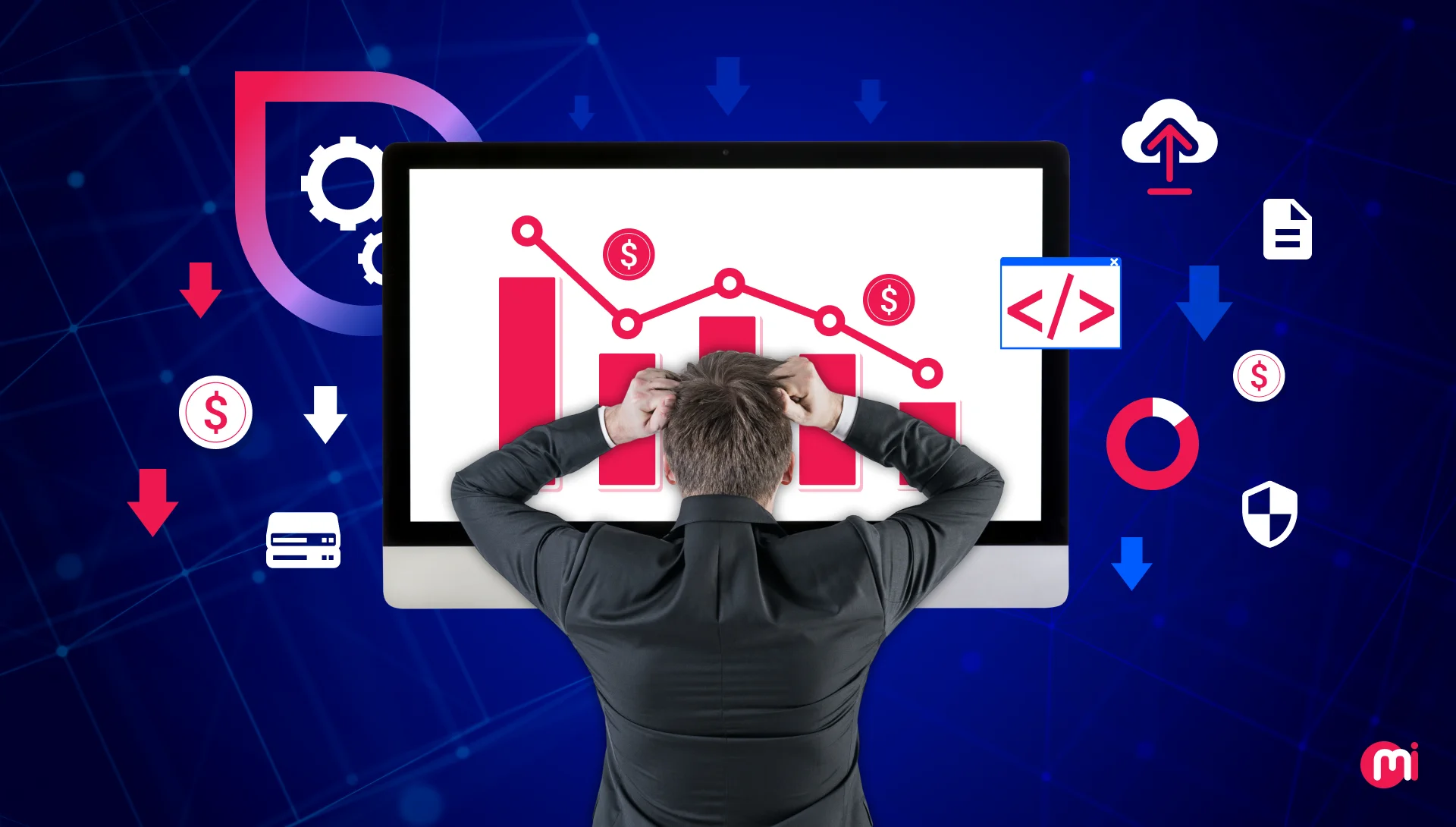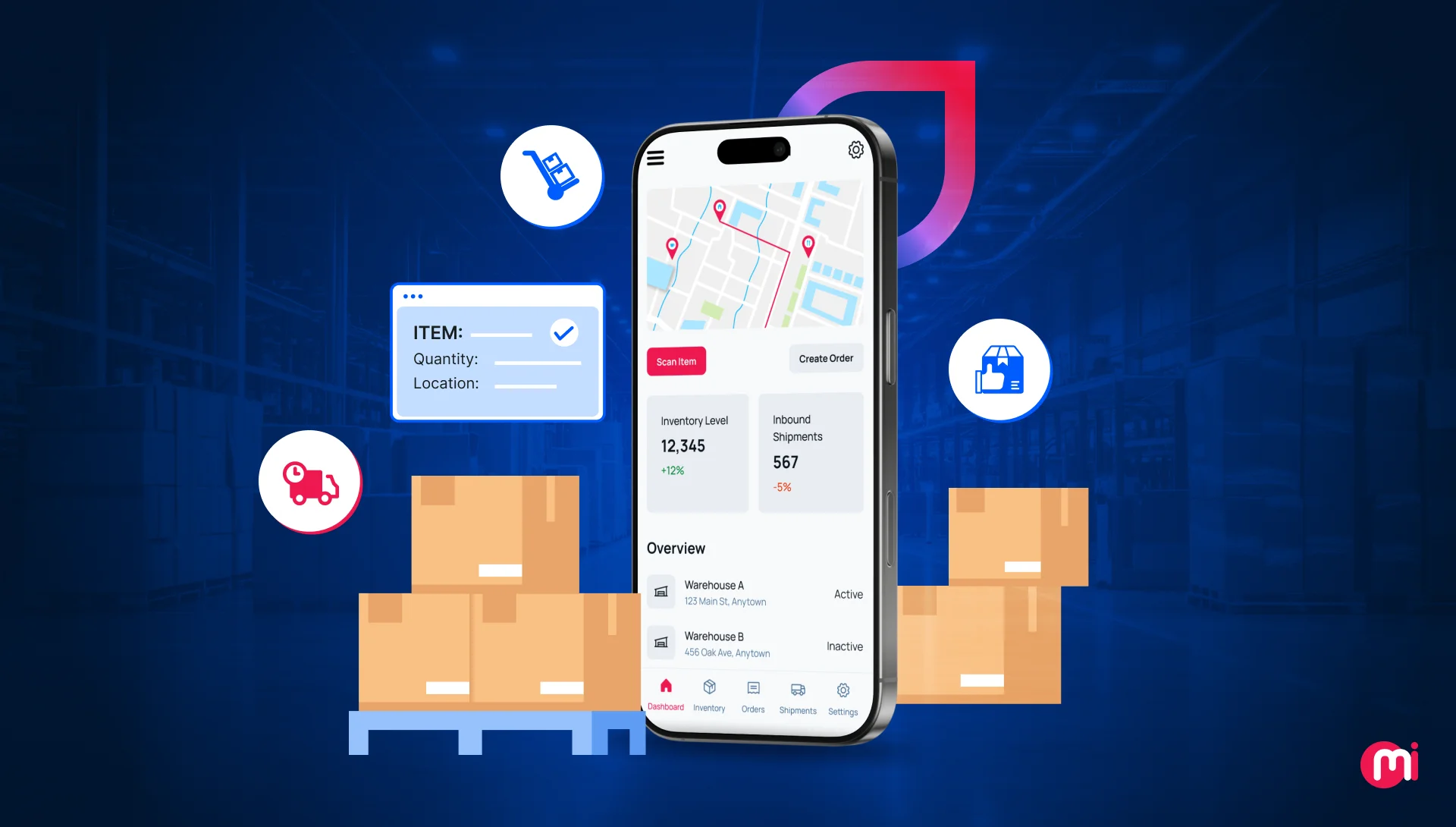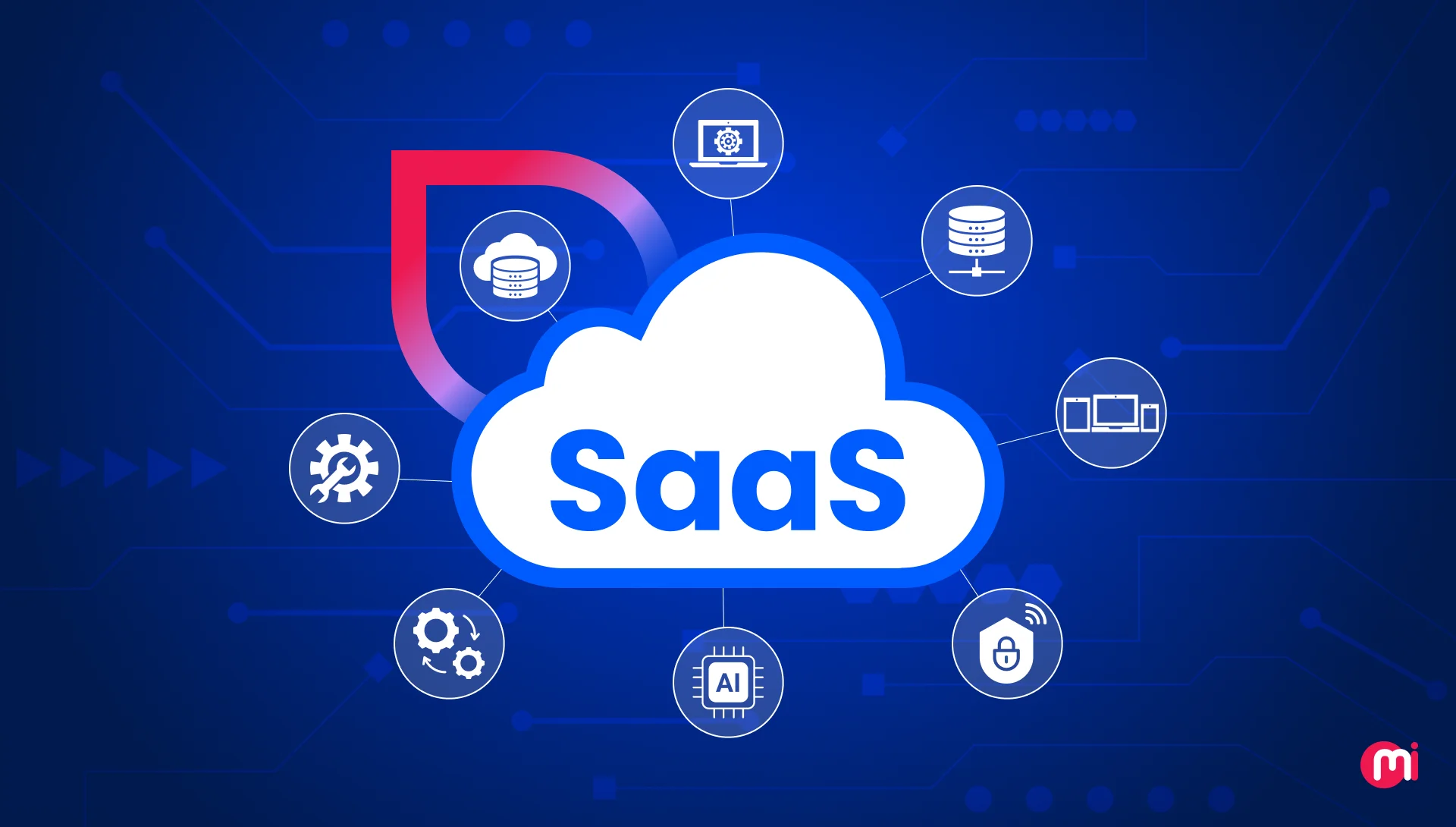Python for Software Development: A Detailed Business Guide
- Software
- October 8, 2024
Python for software development is the first choice of developers and businesses alike. Python is easy to learn, provides enhanced readability, versatility, extensive frameworks and libraries, rapid prototyping, and many more, making software development a breeze. This blog explores every reason why to choose Python for software development, including frameworks, tools, and benefits, along with real-life examples of Python applications.
Google, Pinterest, Spotify, Facebook, Instagram, and whatnot. Have you ever wondered what’s similar in these highly popular and high-performance apps? The one aspect they are identical in is that they all employ Python for software development. Yes, they are excellent examples of apps built using Python, showing why you should choose it to develop software.
Python is a general-purpose, open-source programming language that allows captivating software development. Right from elegant syntax to robust frameworks such as Django, Flask, Web2py, and CubicWeb, Python makes complex software development processes a breeze.
Right from the ease of learning with simple code structure, cross-platform capability, third-party modules, easy prototyping, or you name it, when you opt for Python, you unshackle your business to leverage a plethora of benefits. It not only accelerates the development and time to market but also ensures an enriched ROI with numerous offerings.

Getting intrigued to explore more? However, we glanced at key attributes of Python; it’s just a glance, as there’s more yet to discuss. Let’s examine the know-how on why to consider Python application development so that you can simply choose a Python development company to execute your project idea!
What is Python?
Python is a high-level, versatile, and general-purpose programming language well-known for its ease of use and enhanced readability. It is widely used for software development, web development, data science, and machine learning development services.
The extensive libraries and simple syntax of Python make it the right choice not only for beginners but also for experienced programmers. Businesses opt for software development in Python to leverage its wide benefits.
Python Uses Statistics: Market Share, Adoption & Growth
As of 2024, Python was among the top five most widely used programming languages across the world. With JavaScript at 62% and HTML/CSS at 52.9%, Python secured its position as the third most used programming language, with 51% of users worldwide. Take a sneak peek at the image below for a clear picture!
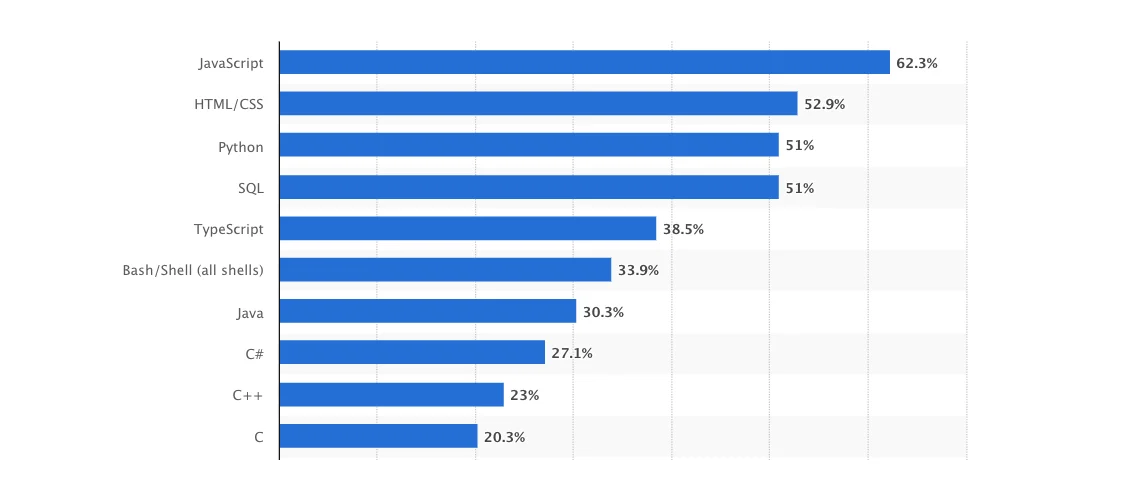
- Rising demand for Python for end-use applications such as web development.
- Streamlined adoption of Industry 4.0 technologies by businesses to elevate productivity.
- Constantly growing dependency on Python over other programming languages.
- Increase in demand for Python for real-time Internet of Things and edge computing.
That’s how Python is constantly growing and has become one of the top trending programming languages preferred by developers and businesses alike for building robust software solutions! As you know the popularity, let’s skip to the assessment of what python use cases look like in the real world!
Common Applications of Python for Software Development
Python is a versatile programming language employed in diverse applications, including software development, web development, machine learning, data science, and automation. The following are the common applications of Python for software development:
- Web App & Software Development: With the ability to handle a variety of tasks and provide a sophisticated user experience, Python is most likely to be used for website development.
- CLI and GUI Development: Python provides a variety of libraries to develop GUI and frameworks for command-line applications and interfaces (CLI), hence is a suitable choice for desktop application development.
- Game Development: Although not an excellent option, Python can be employed for game development.
- Automation and Scripting: The scripting capabilities in Python make it a suitable choice for creating scripts and automating tasks for various purposes.
- Data Analysis and Visualization: Python provides many libraries such as NumPy, Pandas, Matplotlib, and so on to be used for data analysis, manipulation, and visualization.
- Machine Learning and AI: Python provides many libraries like Keras, TensorFlow, and Scikit-learn, enabling the development of machine learning algorithms and models.
- Web Scraping: Businesses use Python to extract data from websites, which is of utmost significance for a variety of purposes, like research and data analysis.
- Desktop Applications: Using frameworks, for instance, PyQt and Tkinter Python, allows development to develop groundbreaking desktop applications.
Why Choose Python for Software Development?
Python software development is an excellent choice for many reasons, including its exceptional readability, ease of use, extensive libraries, and cross-platform development compatibility. It’s also well-known for its versatility, being employed for web development, machine learning, data science, and more. Here are the diverse use cases of Python for software product development services:
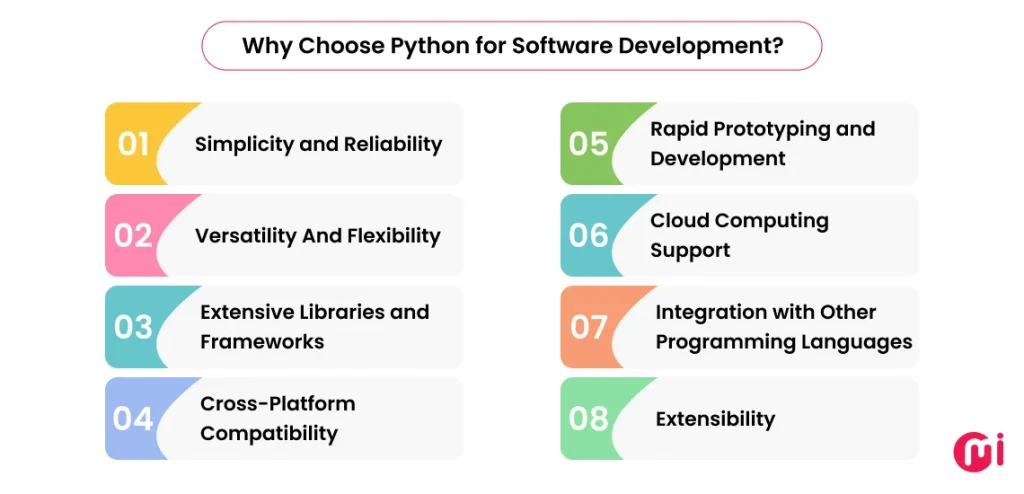
1. Simplicity and Reliability
Known for its simplicity and readability, Python has a short and efficient code structure. With readable syntax, dynamic typing, high-level data structures, string formatting, and many other features, Python ensures short and simple code structure, allowing even newbie developers to create apps timelessly. The technology makes use of a simple, clean, and readable structure, making the code easy to learn and master for programmers.
2. Versatility And Flexibility
Python is well-known for its simple code structure, several features, and functionalities; however, the programming language is also known for its versatility. Developers make use of Python for a variety of purposes like web development, software development, machine learning, animation software, automation, and so on. For example, a web developer may make use of Python for web development and a data scientist for visualizations or data modification.
3. Extensive Libraries and Frameworks
Python provides an extensive collection of libraries and frameworks to accelerate the development lifecycle. Many popular Python libraries, such as PyTorch, NumPy, Pandas, and TensorFlow, allow developers to efficiently tackle complex tasks in machine learning, data science, and more, limiting the need to reinvent the wheel.
Besides, frameworks like FastAPI and Django offer a well-structured foundation and predefined tools, accelerating the development while minimizing boilerplate code and enforcing best practices.
4. Cross-Platform Compatibility
Python’s cross-platform compatibility allows code written in Python to run on a variety of operating systems, including Windows, macOS, and Linux, with nominal modification. Python is an interpreted language, which means it meaning it turns code to bytecode, which is executed by the Python interpreter, enabling it to run across different platforms.
5. Rapid Prototyping and Development
Python’s concise syntax and dynamic typing enable developers for rapid prototyping, development, and iteration. The rapid development cycle is essentially invaluable in the fast-paced tech industry, helping businesses to bring their ideas to life efficiently while adapting to ever-changing requirements.
6. Cloud Computing Support
Support for cloud computing is one of the significant benefits of software development in Python. The programming language enables developers to conveniently develop websites and custom software solutions and save them on the cloud or on the distributed network. By providing support for the cloud, Python allows your business to grow by providing streamlined access to all the crucial data irrespective of time and location.
7. Integration with Other Programming Languages
Being a flexible programming language, Python allows developers to integrate it with other programming languages to create complex applications. Besides, the programming language comes with a variety of features, such as ease of use and efficient error management. For example, you can make use of IDE to craft and manage programs using Python.
8. Extensibility
Python applications and frameworks tend to support extensions and plugins, enabling developers to modify existing features and add new ones without changing the core codebase. For example, the Django web framework supports third-party packages as plugins to extend the functionality. It makes Python an extensible programming language that allows users to create high-performance, feature-rich applications with ease.
What are the Benefits of Using Python for Software Development?
Python provides numerous benefits for software development because of its simplicity, readability, ease of learning, extensive libraries, and many more. Its interpreted nature and dynamic typing lead to accelerated development and easier debugging. Moreover, Python’s open-source nature and large and active community make it a versatile and accessible language. Here are more benefits of using Python for software development.
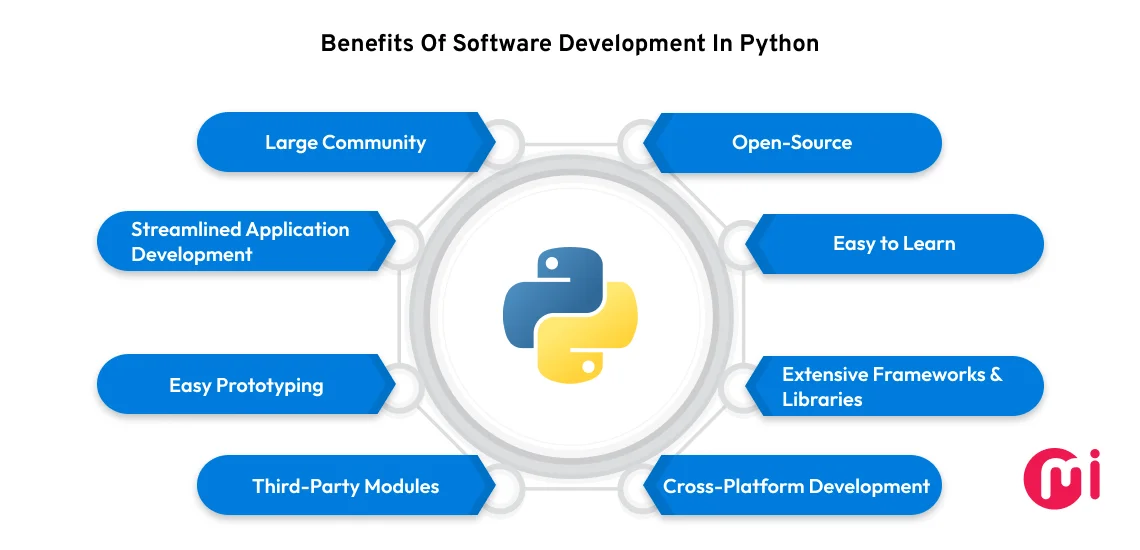
Open-Source
Developed under an OSI-approved open-source license, Python is an open-source programming language that is free to use and distribute, which also includes for commercial purposes. Anyone can make use of Python to develop software solutions without a major initial investment.
Easy to Learn
Thanks to its clear and readable syntax, which closely resembles natural language, making Python easy to learn and use even for beginners. It makes use of indentation rather than braces, which simplifies the code structure. The dynamic typing in Python means you needn’t declare the variable types explicitly.
Moreover, Python’s vast library and straightforward design are crucial advantages of Python, allowing streamlined development and testing. It enables learners to be focused on programming concepts rather than language intricacies. That level of combination of support and simplicity makes Python an excellent language even for entry-level developers.
Extensive Frameworks & Libraries
Python provides a rich set of libraries and frameworks such as Pyramid, Django, Web2py, Falcon, Pandas, PyGame, Scrapy, and SymPy. Several programs are scripted into the standard library and frameworks, which significantly mitigate the length of code to be written. This, as a result, makes Python development convenient for both entry-level as well as experienced developers.
Cross-Platform Development
Python tends to be a cross-platform programming language, meaning a program built using Python for Mac OS X can also run on Linux and Windows with no change to the code. It allows developers to write once and run everywhere, circumventing the need to create separate codes for several platforms. It not only streamlines the development time but also minimizes the efforts and costs of software development.
Third-Party Modules
The Python Package Index (PyPI) contains a large number of third-party modules, allowing developers to extend Python’s competencies with additional modules and libraries for a variety of tasks, likely to range from web development to data analytics. For example, libraries such as Pandas for data manipulation, NumPy for numerical computations, and Requests for HTTP requests.
Easy Prototyping
Simplified prototyping in Python is one of the significant features that allows developers to visualize what the final product will look like. Prototyping in Python tends to be an easy procedure, making it an efficient programming language for web development.
With this feature, developers can get feedback from the end user and make changes accordingly to bring the product in alignment with the requirements. Furthermore, it decreases the development time and expense of the software development project.
Streamlined Application Development
Python comes with fast process-control competencies, making rapid application development (RAD) possible. The language is suitable to be used for web development services as it supports concurrent programming through several mechanisms like threading and multiprocessing, allowing developers to perform multiple tasks simultaneously, ensuring enriched performance.
Moreover, the code written in Python generally runs faster with no delay, making it possible to streamline the software development procedure.
Large Community
Python has been on the market for a long time; it has gained popularity among developers. The language has a wider community, providing assistance to developers as per their needs. Large community support is one of the crucial factors making Python a user-friendly programming language.

What are the Most Popular Python Frameworks and Libraries?
Python frameworks are categorized into micro, full-stack, GUI, testing, and asynchronous frameworks. While full-stack frameworks offer extensive tools for web development, micro frameworks provide lightweight solutions for smaller applications. Testing frameworks automate the process of testing, and asynchronous frameworks are designed to handle concurrent operations and high-end apps. Here are the types of frameworks and their uses you should know:
Types of Python Frameworks
1. Micro Frameworks
Micro frameworks, for example, Flask, Bottle, and CherryPy, are designed specifically to be simple and lightweight. They have limited dependencies and prioritize essential features for web development.
2. Full-Stack Frameworks
Full-stack frameworks provide a comprehensive web development solution. They feature form generators, form validation, and template layouts. Some of the examples of full-stack frameworks include Django, Giotto, and CubicWeb
3. GUI Frameworks
Python GUI frameworks like Tkinter, PyQt, Kivy, wxPython, and PySimpleGUI allow creating graphical user interfaces (GUIs) for apps, making them appealing and user-friendly. They provide tools to simplify the development of interfaces with widgets, such as buttons, menus, and windows.
4. Asynchronous Frameworks
Asynchronous frameworks like Tornado, Sanic, and AIOHTTP make use of the asyncio library, aiming to handle concurrent operations. It makes them suitable for real-time applications and high-performance tasks.
5. Testing Frameworks
Python testing frameworks like Pytest, Unittest (PyUnit), Robot Framework, Behave, and Lettuce automate the software process of software solutions, ensuring errors are detected early in the development cycle and optimizing code quality.
Popular Python Frameworks and Libraries
Most popular Python frameworks include Django, Falcon, Flask, FastAPI, and more—each well-suited for different web development needs. If you’re deciding between API-focused frameworks, understanding the differences in FastAPI vs Flask can help determine which is the right fit for your project.
Python libraries like NumPy, Pandas, and SciPy play a significant role in data science and scientific computing. Furthermore, frameworks like Streamlit and Anvil help create web applications with minimal code. Mentioned below are the top Python frameworks and libraries you need to know:
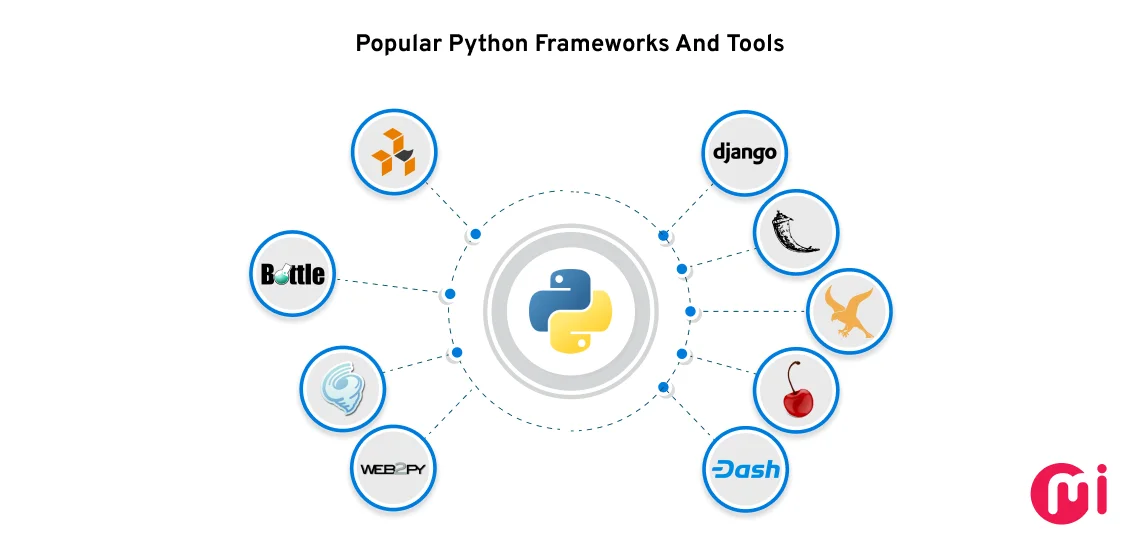
1. Django
This is an open-source web development framework built using Python to create complex code for web apps’ backends. It follows the model-template-views architectural pattern and is maintained by the Django software foundation. The framework is known as one of the simplest, and most flexible frameworks that is less time-consuming, too.
Features of Django
- Makes use of MVC (Model-View-Controller) architecture
- Easy to understand, use, and extend
- Modular approach, allowing additional features to be included in the framework
- Built-in security features include user authentication and protection against common attacks like SQL injection
2. Flask
Flask tends to be a microweb framework developed based on Python. Since it doesn’t require specific tools and libraries, Flask is classified as a microframework. However, it supports extensions to add features as if they were integrated into Flask itself. Inspired by the Sinatra Ruby framework, the framework needs the Werkzeug WSGI toolkit and Jinja2 template. Because of its lightweight and modular construction, Flask is conveniently adjustable.
Features of Flask
- Development server and debugger
- Integrated support for unit testing
- Supports secure cookies
- RESTful request dispatching
- HTTP request handling
- Extensions for extended functionality
3. Falcon
Falcon tends to be a minimalist ASGI/WSGI framework used to build mission-critical REST APIs and microservices, focussing on correctness, reliability, and performance at scale.
Features of Falcon
- ASGI, WSGI, and WebSocket support
- Native asyncio support
- Strict adherence to RFCs
- Python 3.5+ and PyPy 3.5+ support
- Simple API modeling through centralized RESTful routing
- Highly optimized and extensible codebase
- Stable interfaces with an emphasis on backward compatibility
4. CherryPy
Built using Python, CherryPy is an object-oriented web application framework. It is designed for the rapid development of web applications. The framework is lightweight and fast that’s easy to install. Besides, CherryPy provides support for sockets, threads, and protocols.
Features of CherryPy
- HTTP/1.1-compliant, WSGI thread-pooled webserver
- Easy to run multiple HTTP servers
- Support for multiple WSGI servers
- Runs on Python 2.7+, 3.5+, PyPy, Jython, and Android
- Built-in profiling, coverage, and testing support
- Minimalistic syntax to write reusable code
- Comprehensive access to low-level modules
- Logging handler to handle errors in any part of the application
- Very minimal syntax to write reusable code
- Automatic process management in the background
5. Dash
Built using Python, Dash is a framework used to build web applications. It offers a next-level development environment for web applications. Dash can be used as a standalone library or integrated with Apache, Nginx, or any large-scale server. Consider relying on Dash if you’re looking for a framework for web development using Python.
Features of Dash
- Easy-to-use interface with excellent control structure and enhanced support for custom objects.
- Comprehensive access to low-level modules, including external libraries such as XML, and JSON.
6. Web2py
Written in the Python programming language, Web2py is an open-source framework for web application development. It allows developers to program dynamic web content making use of Python.
Features of Web2py
- Built-in components
- Database Abstraction Layer (DAL)
- jQuery for Ajax and UI effects
- Caching
- Robust security
7. Tornado
Tornado is a scalable framework for real-time web application development. Its non-blocking network I/O enables Python to manage hundreds and thousands of open connections, while its synchronous programming model is developed aiming at handling long-lasting network connections. For example, it helps to solve the “C10k problem.
Features of Tornado
- High-performance
- Non-blocking Network I/O
- Asynchronous I/O Library
- WebSocket support
- Enhanced flexibility and scalability
- Robust security
8. Bottle
The Bottle is a simple, fast, and lightweight WSGI microweb framework built based on Python programming language. It makes use of the WSGI application call interface; that’s one of the excellent ways to run a web server. The framework is distributed as a single file module with no dependency except the Python Standard Library. The Bottle is considerably easy but needs some knowledge of WSGI execution.
Feature of Bottle
- Built-in template engine and supports Jinja2, mako, and cheetah templates
- Built-in development server that works with a variety of WSGI-capable HTTP servers
- REST framework support
- Ease of extension by using plugins
- Ajax support
- Complete support of WSGI-based server frameworks
- Reliable schematics with configuration management features
9. CubicWeb
Last but not least, CubicWeb is one of the lightweight web frameworks developed in Python. It’s easy to install, provides support for many protocols, and can easily handle any processing size.
Features of CubicWeb
- Supports sockets, threads, and a wide variety of programming languages, including Ruby, PHP, etc.
- Supports various protocols, like HTTP, on one application.
- Complete access to low-level modules such as external libraries, including XML, and JSON.
- Pre-built modules like Nginx or Apache Web Server.
- Automated process management with in-process cache management facilities.
10. Pandas
Pandas is a powerful Python library for data analysis and manipulation that offers data structures like DataFrames and Series. It provides efficient data structures, specifically the DataFrame, to work with tabular data, and a rich set of functions aiming for data analysis, cleaning, and visualization
Features of Pandas
- Provides Dataframe, a two-dimensional labeled data structure embedded with columns of different types, similar to a spreadsheet or SQL table.
- It imports data from different sources like CSV, Excel, databases, etc., and exports to various formats.
- Handles missing data, removes duplicates, and transforms data types.
- Performs reshaping, sorting, filtering, and grouping data.
- Pandas is well-supported with a large and active community.
11. Numpy
Last but not least, NumPy is a foundational Python library aimed at scientific computing. It offers efficient numerical operations and tools for data analysis. Numpy’s core feature is the ndarray, which is a powerful multidimensional array object, providing versatile and fast manipulation of numerical data.
Features of Numpy
- Multidimensional Arrays (ndarrays) for efficient storage and manipulation of homogeneous data in multiple dimensions.
- Efficient Mathematical Operations for a vast collection of pre-built functions to perform mathematical operations on arrays, like arithmetic, statistical, and trigonometric functions.
- Broadcasting, a robust feature for element-wise operations on arrays of different shapes, automatically expands the smaller array to match the shape of the larger array.
How to Develop Software Using Python?
Similar to other software development, building software using Python involves many stages. These stages include outlining your goals, hiring the right Python development partner, planning the tech stack, developing the software, testing, launching, and scaling. Here’s how each stage contributes to the software development with Python:
1. Outline Your Python Software Goals
This phase includes clearly defining the need, identifying the purpose, target audience, and key features of prospective software. Be it a web app, a data processing tool, or an automation tool, a well-articulated goal assists developers in shaping the development direction while ensuring everyone is aligned from the very beginning.
Key Tasks:
- Conducting market/user research
- Drafting feature list and use cases
- Defining software objectives and KPIs
2. Hire the Right Development Team
In this stage, businesses hire Python developers familiar with Python’s tools, libraries, and ecosystem relevant to the project. It might be Django for web development, Flask for APIs, or TensorFlow for AI development services.
Key Tasks:
- Evaluating technical expertise and project experience
- Considering freelancers, agencies, or an in-house team
- Assessing project management, communication, and cultural fit
3. Plan the Tech Stack and Frameworks
This stage of Python software development deals with selecting the right tools and technologies to support your software’s goals. Since Python has a vast ecosystem, opting for the appropriate frameworks, databases, and integrations is crucial to ensure enhanced performance, scalability, and development speed.
Key Considerations for Technology Selection:
- Web frameworks like Django, Flask
- Front-end technologies like React, Vue.js
- Databases, for example, PostgreSQL, MongoDB
- Hosting/Cloud platforms involve AWS, Heroku
4. Development and Testing
This phase includes writing clean, maintainable code and testing the software. Python provides support for test-driven development (TDD) and tools for unit, integration, and functional testing. It helps ensure the software remains robust and bug-free.
Key Practices:
- Agile development with sprints and iterations
- Version control like Git
- Automated testing and continuous integration
- Code reviews and quality assurance
5. Launch and Scale
In this stage, the product gets deployed to the intended environment. Once it’s deployed, the developers keep monitoring its performance and gather user feedback. As user demand grows, they make adjustments to scale the infrastructure, optimize features, and ensure security and uptime.
Key Actions:
- Using CI/CD pipelines for deployment
- Setting up monitoring and analytics tools
- Preparing for scalability (load balancing, caching, database optimization)
- Rolling out updates and gathering user feedback
Real-Life Examples of Applications Built Using Python
Some prominent examples of the software built using Python include YouTube, Instagram, Netflix, Amazon, Pinterest, Dropbox, and many more. Here’s all about the real-life application of Python:
- Facebook: It uses Python for several aspects, including backend services, automation and scripting, prototyping, APIs and microservices, testing and quality assurance, and so on.
- Instagram: Python is used in Instagram’s backend infrastructure, and it plays a significant role when it comes to handling requests, managing databases, and ensuring an enhanced user experience.
- Netflix: Netflix chose Python for its various attributes, such as Python’s several modules, its excellence in video processing and data science as well as animated and VFX content creation.
- YouTube: The platform employs Python for multiple aspects like website templates, backend operations, video controls, and many more.
- Amazon: Backend web development, data processing, server-side code, and many others that Python can do, but the main reason Amazon mostly prefers Python is its ability to handle big data.
- Pinterest: Pinterest, an image-based social media platform, employs Python primarily for its ease of use and extensive libraries. It leverages Python for many aspects like backend development, machine learning, data processing, automation and scripting, etc.
- Spotify: Spotify makes use of Python for the backend and data analysis because of its exceptional speed and the benefits of machine learning.
- Uber: Uber chose Python for backend and frontend functions. The platform needs to make many calculations; hence, Uber’s backend is built using Python, which anticipates booking and services, traffic, arrival times, approximate reaching time to the destination, and more.
- Quora: The very platform makes use of Python for its robust ecosystem, excellent development speed, enhanced flexibility, wider community support, and the like.
Choosing MindInventory: A Smart Move for Premier Python Development
Working for more than a decade, MindInventory is a trendsetter when it comes to providing robust, and high-end software development services to businesses worldwide. We have built various high-end tailored solutions using Python, including CodeDog, Sidepocket, Zammans, and Bipedai that glimpse our dexterity and accomplishment in software development with Python.
CodeDog is an open-source project that automates speech-to-text, and text-to-speech conversion. It has become a reliable platform, making communication more accessible and efficient to people from a diverse background and use cases.
Sidepocket tends to be a tactical asset allocation robo-advising app, designed to decrease the drawdown and risk while increasing the diversification and profits to help individuals with transformative approaches to investment. Sidepocket experienced a 95% accuracy rate, 70%
increase in app performance, and a 15% increase in revenue.
Zammans is a holiday home booking platform, revolutionizing the way travelers find and manage their accommodations. We helped Zammans establish a dedicated support system and enhance user experience. The client received a 21% hike in revenues, 10K+ user inquiries monthly, and 4.2* rating online.
Last but not least, we built BipedAI, a smart navigation harness wearable over the shoulders and tailored for blind/visually impaired people as well as hemispatial neglect patients. The product delivered a 75% improvement in obstacle avoidance efficiency, a 60% reduction in navigation-related stress, and a 50% enhancement in user satisfaction relating to GPS instructions.
Do you have an innovative software development idea? If yes, hire Python developers, build your own team, and get your unique software development idea turned into a reality that meets your expectations!
FAQs on Python Development
Python comes embedded with an excellent combination of versatility, readability, cross-platform compatibility, extensive libraries, wider community support, and rapid development capabilities. This makes Python a preferred choice of developers across the globe.
It only takes a few steps to develop software using Python. First off, consider assessing your needs; after that, configure the tech stack and develop a graphical user interface (GUI). Once you’re done with development, conduct proper testing and launch the software to ensure it runs smoothly, meeting your comprehensive business requirements.
The general cost of software development with Python may range between $20000 and $1,50,000; it differs depending on a variety of aspects. These cost variables may include the project’s complexity, the features you require, the developers you hire, their expertise and experience in the relevant domain, and many more.





